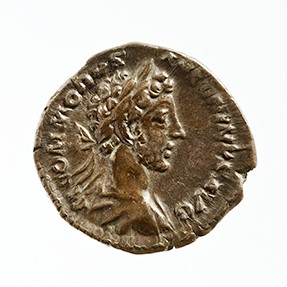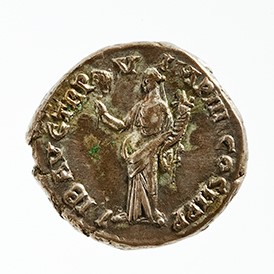Acquisition number: 1967.13
Obv.: Bust of Commodus r., laureate, bearded, draped; hair in tight curls. M(arcus) COMMODVS ANTONINVS AVG(ustus).
Rev.: Liberalitas standing l., draped, cornucopiae in left hand and abacus in right. LIB(eralitas) AVG(usti) TR(ibunicia) P(otestate) V IMP(erator) IIII CO(n)S(ul) II P(ater) P(atriae).
Title: Denarius of Commodus - 1967.13
Acquisition number: 1967.13
Author or editor: Beryl Rawson
Culture or period: Roman Imperial
Date: AD 180
Material: Metal - Silver
Object type: Coins - Roman
Dimensions: 18mm (w)
Origin region or location: Italy
Origin city: Rome
Display case or on loan: 7
Keywords: Coin, denarius, Roman, Imperial, Commodus, Liberalitas
Seaby, H.A., Roman Silver Coins (London, B.A. Seaby, 1967) 301; Mattingly, H., E.A. Sydenham, C.H. Sutherland, R.A. Carson, The Roman Imperial Coinage 13 vols (London, Spink, 1923-1994) III 10a and pl. XIV no. 264 (aureus); Robertson, A. Roman Imperial Coins in the Hunter Coin Cabinet, University of Glasgow 5 vols (Oxford: Oxford University Press, 1962-1982) II 410 no. 3 and pl. 113; Mattingly, H.,Coins of the Roman Empire in the British Museum, 6 vols (London, 1965) 3 note.
1967.13
Denarius of Commodus
3.473 g. AD 180
Obv.: Bust of Commodus r., laureate, bearded, draped; hair in tight curls. M(arcus) COMMODVS ANTONINVS AVG(ustus).
Rev.: Liberalitas standing l., draped, cornucopiae in left hand and abacus in right. LIB(eralitas) AVG(usti) TR(ibunicia) P(otestate) V IMP(erator) IIII CO(n)S(ul) II P(ater) P(atriae).
Commodus was the son of Marcus Aurelius and Faustina the Younger. He here bears the name Antoninus which his father took (by adoption) from Antoninus Pius. Commodus had begun to acquire the titles of a future emperor early. In AD 175 (aged just fourteen) he received a military command on the northern frontier and at the end of the year had tribunician power conferred on him. (Hence ‘TR. P. V’ dates this coin between December AD 179 and December 180.) He spent AD 176 with his father in the East, settling affairs after the revolt of Avidius Cassius, and returned to Rome at the end of the year to share a triumph with his father (thus imperator for the first time). Commodus was consul in AD 177, and soon after acquired the title ‘Augustus’ which made him virtually joint emperor. The continuing warfare on the northern front required the presence there of both father and son, and Commodus was acclaimed imperator for the second and third time in AD 178 and 179. When Marcus Aurelius died at the front in March AD 180, Commodus made a speedy peace and returned to Rome. His accession and return to Rome were marked by victory celebrations (‘IMP. IIII’ this year) and by the distribution of largesse (hence ‘Liberalitas’: cf. 1966.47). He held a second consulship, and became pater patriae (father of his country).
Commodus distributed largesse in each of the years AD 180, 181, and 182, but then there was a gap until 186, when there were probably two. These may have been designed to ensure loyalty and popularity after the execution of Perennis, prefect of the praetorian guard, in AD 185 (and may also reflect the removal of Perennis’ cautious financial policy). The last two largesses of Commodus’ reign were given in the last year of his life (AD 192).
Commodus, the first non-adoptive heir for nearly a century, was the last of the three Antonine emperors. (But the Severan dynasty took the Antonine name on themselves, to try to establish some continuity with the previous regimes: cf. Caracalla on 1966.53 and Elagabalus on 1966.55.)
Some of the portraiture on Commodus’ coins (esp. the gold) is very fine. Many works of art represented him, often in the guise of Hercules.
Seaby, H.A., Roman Silver Coins (London, B.A. Seaby, 1967) 301; Mattingly, H., E.A. Sydenham, C.H. Sutherland, R.A. Carson, The Roman Imperial Coinage 13 vols (London, Spink, 1923-1994) III 10a and pl. XIV no. 264 (aureus); Robertson, A. Roman Imperial Coins in the Hunter Coin Cabinet, University of Glasgow 5 vols (Oxford: Oxford University Press, 1962-1982) II 410 no. 3 and pl. 113; Mattingly, H.,Coins of the Roman Empire in the British Museum, 6 vols (London, 1965) 3 note.

